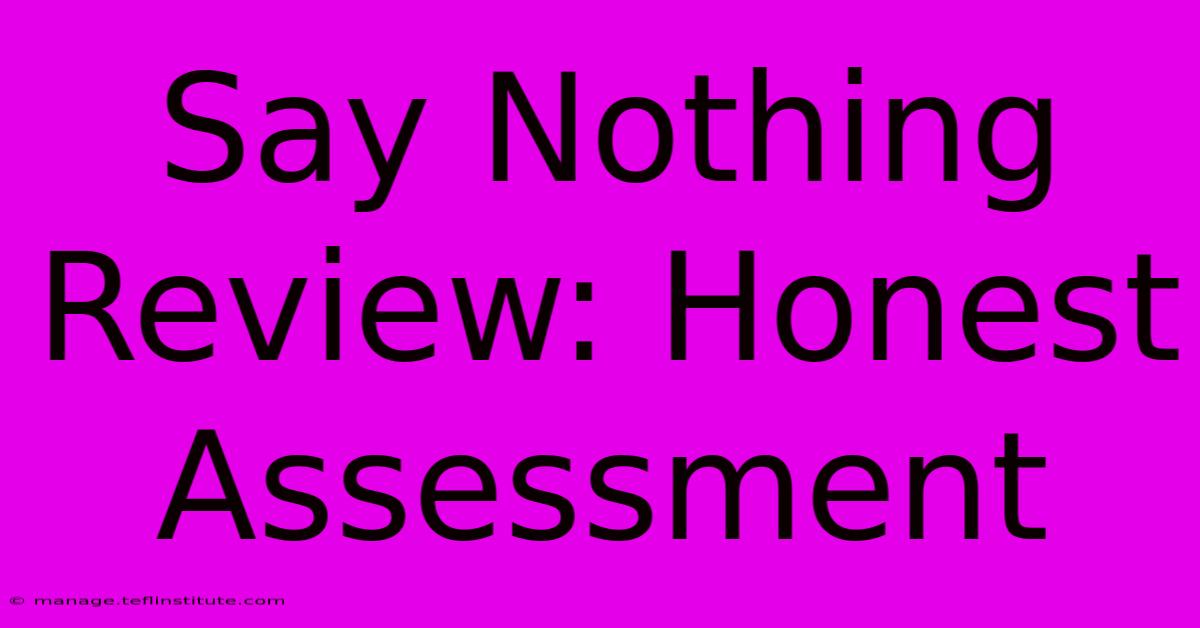Say Nothing Review: Honest Assessment

Table of Contents
Say Nothing: A Powerful but Uneven Exploration of the Troubles
Patrick Radden Keefe's Say Nothing: A True Story of Murder and Memory in Northern Ireland is a sprawling, meticulously researched narrative that delves into the heart of the Troubles in Northern Ireland. While undeniably compelling in its scope and detail, the book’s success is somewhat uneven, oscillating between gripping storytelling and moments of overwhelming information.
Keefe’s central focus is the 1972 abduction and murder of Jean McConville, a widowed mother of ten, by the Provisional Irish Republican Army (IRA). McConville, a suspected British informant, became a symbol of the brutal violence that characterized the conflict, a violence often shrouded in secrecy and denial. Through McConville's story, Keefe weaves a larger narrative encompassing the broader political, social, and psychological landscape of Northern Ireland during this tumultuous period.
The strength of Say Nothing lies in Keefe's masterful storytelling. He possesses a rare ability to humanize complex characters, even those implicated in horrific acts. We are presented with the perspectives of both IRA members and British security forces, allowing for a nuanced understanding of the motivations and justifications – however flawed – behind their actions. The detailed accounts of interrogations, court proceedings, and the subsequent decades-long search for McConville’s remains are particularly gripping, leaving the reader breathlessly turning the pages.
Keefe’s meticulous research is evident throughout the book. He painstakingly reconstructs events, relying on interviews with key players, archival documents, and investigative reporting. This level of detail is undoubtedly a significant contribution to our understanding of the Troubles, providing a comprehensive and richly textured account of a deeply complex historical period.
However, the sheer volume of information can at times feel overwhelming. The book’s length, while necessary to encompass such a vast subject, can occasionally lead to a sense of being bogged down in detail. The numerous characters and interwoven storylines, while adding to the richness of the narrative, can also make it challenging to keep track of all the moving parts.
Furthermore, while Keefe strives for objectivity, a certain degree of authorial bias, however subtle, seems unavoidable given the nature of the subject matter. The reader is left to grapple with the complexities of the situation and draw their own conclusions, but the narrative’s structure subtly guides the reader towards a particular understanding of the events.
In conclusion, Say Nothing is a significant contribution to the historical record of the Troubles. Keefe's powerful storytelling and meticulous research make it a compelling and often heartbreaking read. While the sheer volume of information can occasionally be overwhelming, the book’s strength lies in its ability to humanize the victims and perpetrators alike, offering a nuanced and multifaceted perspective on one of the most significant and tragic conflicts of the 20th century. It's a book that stays with you long after you finish reading, prompting reflection on the lasting legacy of violence and the enduring struggle for peace.

Thank you for visiting our website wich cover about Say Nothing Review: Honest Assessment. We hope the information provided has been useful to you. Feel free to contact us if you have any questions or need further assistance. See you next time and dont miss to bookmark.
Featured Posts
-
Davina Mc Call Brain Surgery After Tumor
Nov 15, 2024
-
England Vs Greece Live Score Carsleys Role
Nov 15, 2024
-
Sydney Sweeney Hollywood Empowerment Is Fake
Nov 15, 2024
-
Sydney Sweeney Hollywoods Fake Feminism Exposed
Nov 15, 2024
Latest Posts
-
Indonesia Vs Japan World Cup Qualifiers
Nov 15, 2024
-
How To Watch Indonesia Vs Japan Today
Nov 15, 2024
-
Watch Indonesia Vs Japan Live Tv And Stream
Nov 15, 2024
-
Indonesia Vs Japan Watch Live Today
Nov 15, 2024
-
Watch Indonesia Vs Japan World Cup Game
Nov 15, 2024
-
Indonesia Vs Japan Start Time And Channels
Nov 15, 2024
